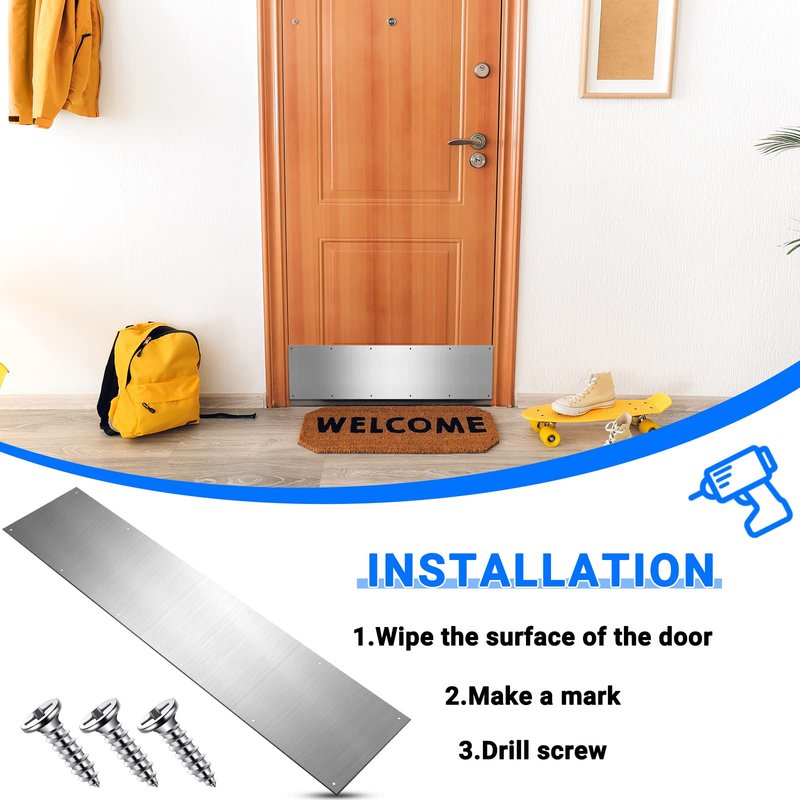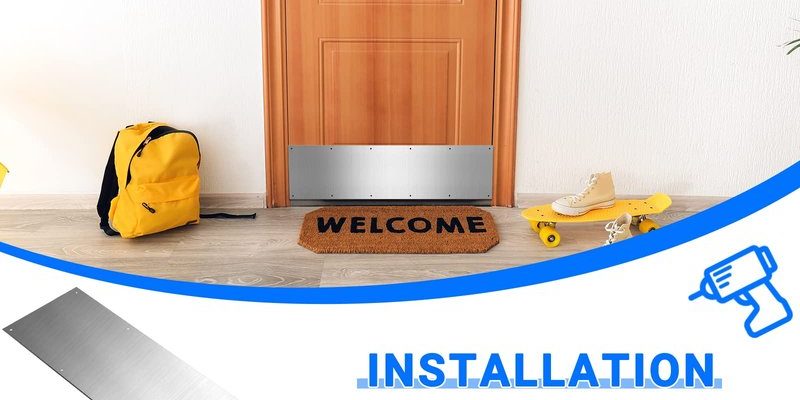
This issue pops up with all types of kick plates, whether you bought a shiny brass model for a classic wood door or a sturdy stainless steel one for a steel entryway. Brands like National Hardware and Prime-Line have their own installation tricks, but the problem of a kick plate that’s too wide is universal. Honestly, it’s not about the quality of the hardware—it’s about matching sizing to your door and knowing what to do when things don’t line up. Let’s break down why this happens and—most importantly—how to fix it in a way that looks clean and professional.
Why Kick Plates Are Often Too Wide
You might be scratching your head, wondering why something as simple as a kick plate doesn’t always fit straight out of the box. The answer is, most kick plates come in standard sizes, while doors themselves can be anything but standard. Even if your door says it’s 36 inches wide, small differences in door trim, edge bevels, or manufacturing quirks can throw off the fit. Manufacturers like to keep production simple, so they offer a handful of “standard” kick plate widths—usually 28″, 30″, 32″, and 36″. But in the real world, doors are like snowflakes: close, but rarely identical.
Here’s the thing: doors can also have rounded edges or decorative panels that make a perfectly-sized kick plate look awkward or out of place. Sometimes, you might even find that the spacing for hinges or handles eats up a bit of door real estate, which means a full-width kick plate can get in the way. And if your door is older, you could be looking at non-standard widths that haven’t been sold at hardware stores for decades.
So, is this a design flaw? Not really. It’s just the reality of mass-produced parts meeting the unique quirks of your home. The trick is knowing that *adjustments are normal*, and there’s no shame in making a new purchase work for your door.
Assessing the Problem: How Wide Is Too Wide?
Before you grab a saw or start searching for a return receipt, it’s smart to figure out *exactly* how much wider your kick plate is compared to your door. Here’s a step-by-step way to check and get a sense of what you’re dealing with:
- Remove the kick plate from the packaging and hold it against the bottom of the door. Make sure it’s centered, with equal overhang on both sides.
- Check the fit visually. If the kick plate extends past the edge of the door at all, it’s too wide. Even a quarter inch can snag on trim or keep the door from closing.
- Measure both the kick plate and the door width with a tape measure. Write down the measurements, and subtract the door width from the kick plate width.
- Decide how much you need to remove. In most cases, you want the kick plate to be about 2 inches narrower than the door—leaving a 1-inch gap on each side for clearance.
You might be surprised how a “36-inch” kick plate can actually be closer to 36 3/4 inches, or how a door labeled as 36″ is really only 35 3/4 inches wide. Measuring is everything here. If the overhang is less than 1/8 inch on each side, you might get away with it. Any more than that, and it’s time to trim.
Tools and Materials for Trimming a Kick Plate
Trimming a kick plate isn’t rocket science, but having the right tools will make the process way smoother. Here’s what you’ll need if you plan to take a standard brass, stainless steel, or aluminum kick plate and customize it:
- Measuring tape – For getting accurate measurements of both the door and the kick plate.
- Permanent marker or masking tape – To mark your cutting lines clearly.
- Metal straightedge or ruler – For drawing a perfectly straight line across the kick plate.
- Tin snips, hacksaw, or angle grinder – Depending on the thickness of your kick plate. Tin snips handle thinner (aluminum) plates, while a hacksaw or grinder works for beefier brass or stainless steel models.
- Metal file or sandpaper – To smooth out any sharp or rough edges after trimming.
- Clamps (optional but strongly recommended) – To keep the kick plate steady while you cut.
- Protective gloves and eyewear – Safety first, especially if you’re using power tools.
Don’t have these tools? Your local hardware store can often cut metal to size if you bring in both the kick plate and the right measurements. Just ask at the counter—they’re used to requests like this, and it might save you a DIY headache.
Step-by-Step: How to Trim a Kick Plate That’s Too Wide
Let me walk you through the trimming process. Even if you’re not the handiest person, taking it slow and steady is the key. Here’s how it goes:
- Mark your cut lines. After measuring, use your marker and straightedge to draw a cutting line on each side of the kick plate, so you’re removing equal amounts from both ends (unless the holes for screws are pre-drilled—then you may need to adjust).
- Clamp the plate to a stable surface. If you have a workbench, great. If not, use a sturdy table and some clamps to prevent movement.
- Cut along your lines. For aluminum, tin snips work fine. For stainless steel or brass, a hacksaw or angle grinder will make cleaner cuts. Take your time—don’t rush it.
- Smooth the edges. Newly cut metal is sharp. Use a metal file or sandpaper to round off and smooth the edges completely.
- Test the fit. Hold the trimmed kick plate against your door again. Make sure it lines up properly, leaving that 1-inch buffer on each side.
It can be tempting to “eyeball” the cut, but honestly, the little bit of extra time spent measuring and marking pays off. Nothing’s worse than a kick plate that’s still crooked—or now too short—after all that trouble!
What If You Can’t Trim the Kick Plate?
Sometimes, you just don’t have the tools or confidence to cut metal. No shame in that! Here’s what you can do if trimming isn’t on the table:
- Return or exchange the kick plate for a smaller size. Many brands, including National Hardware and Prime-Line, offer returns if the product hasn’t been installed.
- Look for a custom-size kick plate online. Several online retailers will cut kick plates to the exact width you need—just enter your measurements before ordering.
- Check for adjustable or flexible kick plates. Some newer models can be scored and snapped to the right size with a basic utility knife (though these are usually for lightweight aluminum plates only).
- Visit a local hardware store or metalworking shop. Most can cut the plate for you for a small fee—and often while you wait.
If you end up going the professional-cutting route, make sure to bring exact door measurements and mention any pre-drilled holes or design features. Custom work costs a bit more, but the perfectly tailored look is worth it.
Comparing Kick Plate Materials: Brass, Aluminum, and Stainless Steel
Here’s something you might not have considered: what your kick plate is made of makes a big difference in how easy it is to trim or adjust. Let me break it down:
- Aluminum kick plates are lightweight, budget-friendly, and the easiest to cut with tin snips or a basic hacksaw. They’re a great choice for DIYers who want flexibility. Plus, they won’t rust, so they’re popular on exterior doors.
- Brass kick plates look fancy and come in shiny finishes, but cutting them is a bit tougher than aluminum. You’ll want a fine-toothed hacksaw or a power tool. Brass is softer than stainless steel, so it’s still manageable—just go slow to avoid bending or scratching the surface.
- Stainless steel kick plates are the toughest. They resist scratches and wear beautifully but are a pain to trim with hand tools. Most folks bring these to a shop or use an angle grinder at home. Wear safety gear and work slowly.
Honestly, if you’re nervous about cutting, aluminum is your friend. Brass is doable with patience. Stainless steel? Consider letting a pro handle it, especially if it’s your first time handling an angle grinder.
Preventing the Problem: How to Choose the Right Kick Plate Size
Let me explain how you can avoid this hassle next time around. The best fix for a kick plate that’s too wide is simple: buy the right size from the start. But since that’s not always straightforward, here are some things to keep in mind:
- Measure the door width, not just the opening. Use a tape measure to check the actual face of the door, corner to corner, ignoring trim or weatherstripping.
- Subtract 2 inches from your measurement. This leaves a 1-inch gap on both sides so the kick plate doesn’t rub against the door frame or hinges.
- Consider any design elements. If your door has deep panels, rounded edges, or ornate trim, factor that in. Sometimes it’s better to size down a bit more than to risk overhang.
- Double-check manufacturer specs before you buy. Not all “36-inch” kick plates are really 36 inches wide. Always check the exact dimensions in the product listing.
It’s a little more effort up front, but you’ll thank yourself later. The right-size kick plate not only saves you time, but it also makes your door look crisp and finished.
There’s nothing wrong with adjusting hardware to fit your space. Doors and kick plates rarely match up perfectly right out of the box—but with a little patience and the right approach, your fix will look like it was custom-designed.
Final Steps: Installing Your Kick Plate for a Clean Finish
Once your kick plate fits perfectly, installation is the easy part. Here’s what to do for a polished—almost professional—look:
- Clean the bottom section of the door before installing, especially if it’s an exterior door that’s picked up dust or dirt.
- Use the kick plate as a template to mark and pre-drill holes for screws, if it doesn’t come with pre-drilled holes. Make sure everything is level and centered.
- Apply double-sided tape or adhesive caulk if you don’t want visible screws (just check that the adhesive is suitable for your door’s material and the outdoors, if needed).
- Attach the kick plate, starting with screws in the center and working outward to prevent bowing.
- Wipe away fingerprints and dust. A microfiber cloth and some glass cleaner give it a showroom shine.
Take your time lining things up. Kick plates are one of the first things people see at your front door, so a neat, even fit makes a big difference.
Wrapping Up: Take the Guesswork Out of Kick Plate Troubleshooting
A kick plate that’s too wide for the door is a classic hardware hiccup—annoying, but totally fixable. Whether you trim it yourself, swap it for a better-fitting model, or call in a pro, the main thing is lining up your hardware with your door’s real-world quirks. Brands like National Hardware and Prime-Line design their kick plates for standard doors, but your home is unique, and sometimes the “standard” just isn’t standard enough.
Remember: *There’s no need to settle for a clunky, overhanging plate that snags every time you open your door.* With careful measuring, some simple tools, and a bit of patience, you’ll end up with a kick plate that looks clean, does its job, and actually fits the space. And that’s one more home detail you can check off your list—done right, and done your way.
